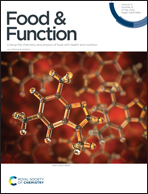Asiatic acid from Cyclocarya paliurus regulates the autophagy–lysosome system via directly inhibiting TGF-β type I receptor and ameliorates diabetic nephropathy fibrosis
Abstract
Diabetic nephropathy (DN) fibrosis is a major cause of end-stage renal disease with unsatisfactory therapy drugs and a low 5-year survival rate. There is a lack of specific and effective treatment drugs. In the present study, we report that asiatic acid (AA), a triterpenic acid found in Cyclocarya paliurus, has good anti-fibrosis activity both in vitro and in vivo. The STZ-induced diabetic model of rats was used to investigate the effects of AA on DN fibrosis. A 15-week AA treatment (10 mg kg−1 or 30 mg kg−1) markedly decreased urine albumin and blood urea nitrogen levels, and ameliorated increased mesangial matrix and glomerular fibrosis. HG + TGF-β1-induced HK-2 cells were applied to evaluate the anti-fibrosis effect of AA. The results revealed AA selectively blocked the interaction of TGF-β type I receptor (TGF-βRI) with Smad3 by binding to TGF-βRI, suppressed the subsequent phosphorylation and nuclear translocation of Smad3, and downregulated the major fibrotic protein expression of collagen I, fibronectin and a-smooth muscle actin (α-SMA), thereby switching the progress of epithelial–mesenchymal transition (EMT). Furthermore, the protein levels of LC3 and LAMP1 were significantly altered by AA administration, implying that the autophagy–lysosome system might be involved in DN fibrosis. However, the anti-fibrosis capacity of AA was partly counteracted by an autophagy–lysosome inhibitor (chloroquine). These findings indicate AA could decrease TGF-β1 secretion and suppress tubulointerstitial fibrosis by directly inhibiting TGF-βR1 and activating the autophagy–lysosome system. Altogether, AA may be a potential candidate drug for preventing DN fibrosis.



 Please wait while we load your content...
Please wait while we load your content...